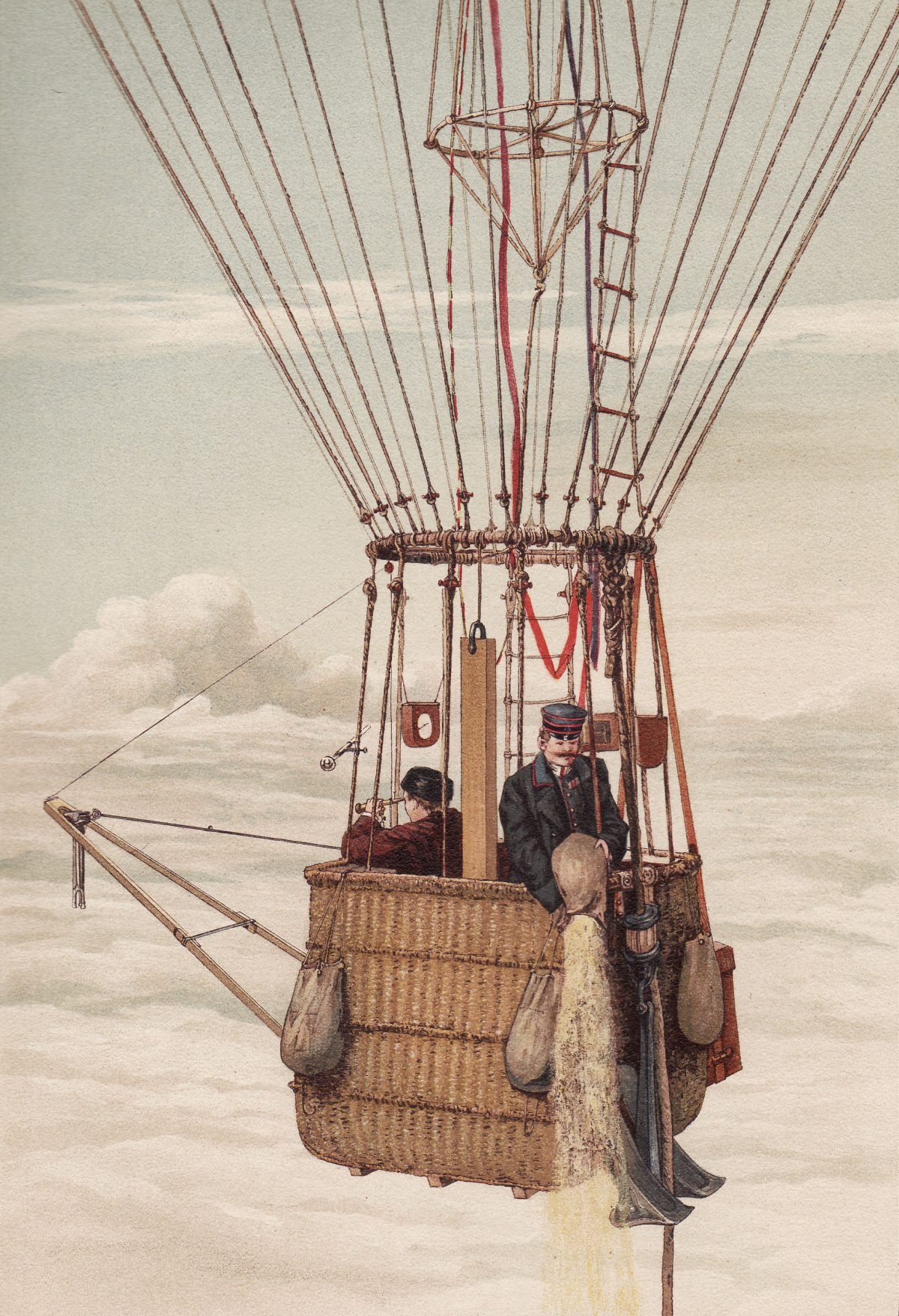Featured image: Reconstruction of one of the earliest scientific weather balloon soundings, a manned balloon flight by the Phönix in 1894. The drawing was made a few years later by the balloon pilot, Hans Groß (right), who was also an artist. Source: Wikimedia Commons (public domain).
Modern weather balloons are unmanned and are instead equipped with radio transmitters which send the measurements back to the observation station in real-time. However, most of the early balloon measurements were carried out in manned flights like this one, with a pilot (in this case, Groß, 1860-1924) flying the balloon and a meteorologist (Arthur Berson, 1859-1942, in this case) recording measurements. This particular flight was organised under the supervision of Richard Aßmann (1845-1918). For movie fans interested in these fascinating but often dangerous early flights, the 2019 film, “The Aeronauts”, was an enjoyable fictionalised dramatisation loosely adapted from similar flights by an earlier (English) meteorologist/pilot team of James Glaisher and Henry Tracey Coxwell, but with Coxwell replaced in the movie by a fictional female pilot called “Amelia”.
Summary
In this post we briefly summarise some of the progress we have made in our atmospheric physics research since our 2014 papers.
Tucson, Arizona (USA) presentation (July 2019)
In 2019, we (Michael & Ronan) were invited to give a presentation on our weather balloon research that we have summarised elsewhere on this blog at the Doctors for Disaster Preparedness Meeting (20-21 July 2019, Tucson, Arizona, USA). If you have already read our “Summary: “The physics of the Earth’s atmosphere” Papers 1-3” post (which generated a lot of discussion in the comments section) then you will probably be familiar with much of this material. However, whether you have already read that post or not, if you are interested in our weather balloon analysis, you might find our presentation helpful.
The talk (a little over 1 hour long) can be viewed here:
You can download a copy of the slides we used here.
The significance of the Local Thermodynamic Equilibrium assumption to the “greenhouse warming” theory
Following the talk above, we received a number of e-mails asking us to elaborate on what exactly the Local Thermodynamic Equilibrium (LTE) assumption is, and why it is such a fundamental (but mistaken) assumption for the current Global Climate Models (GCMs) and more generally for the greenhouse warming theory. Several people were also asking for more information about the part of Albert Einstein’s research which Michael refers to in the talk. For that reason, we wrote up a short pdf explaining the significance of these points and how this combines with our findings from our weather balloon research:
This pdf is quite a technical document and we wrote it for people who have already studied our talk above, so we don’t recommend jumping into it until you have watched the talk above and preferably our earlier “Summary: “The physics of the Earth’s atmosphere” Papers 1-3” post. (Ideally, we also recommend reading our three “The physics of the Earth’s atmosphere” OPRJ articles, but we appreciate these are long and detailed papers, so reading them may require a longer investment of time).
Our research is ongoing…
Since we published our three “The physics of the Earth’s atmosphere” papers which we described when we first launched this website on 21st February 2014, we have received a lot of feedback from hundreds of scientists on our analysis. Some of this feedback has been negative and some has been positive, but most of the feedback has been encouraging and supportive. We have also been building on our early analysis and have been discovering many fascinating new insights into how the atmosphere behaves.
We published our first three papers on our Open Peer Review Journal website so that we could have an open peer review discussion on our analysis, rather than using the standard closed peer review approach that is usually adopted. As scientists, we found this new open peer review approach far more challenging, but also more scientifically rewarding than the standard approach. So, it is definitely an approach we plan on returning to later.
However, at present, in academia, many researchers only really pay attention to papers that have been published in a journal with a reasonable “JCR Impact Factor” or “CiteScore“, most of which use the standard closed peer review approach. Therefore, we are submitting our next few papers on our weather balloon research to such journals.
Unfortunately, the closed peer review approach can take anywhere from a few months to 1-2 years per article, and while the peer review process is ongoing, you are discouraged from discussing the process. Therefore, for readers who are curious about progress on our atmospheric physics research, we ask you for a little more patience! But, in the meantime, we can tell you that our work is continuing and we think our latest findings are intriguing.
